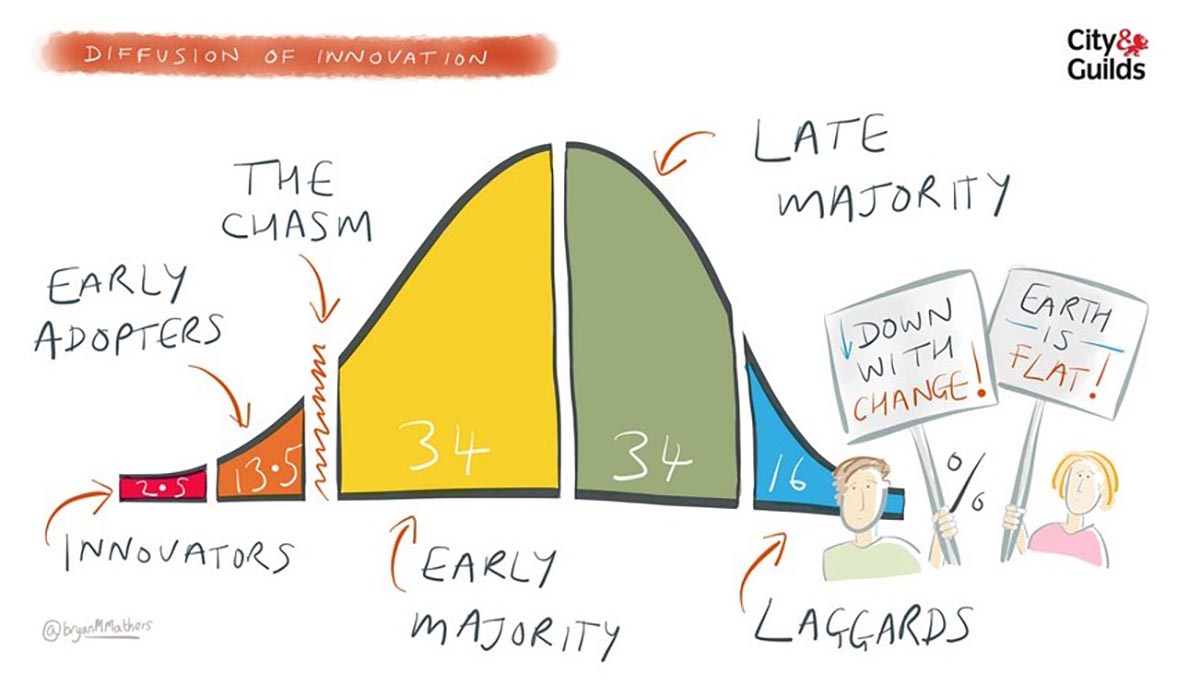The Diffusion of Innovation theory is a model that explains how new ideas, concepts, or practices can spread within a community. Originally developed to describe how new technology is adopted, this model is also applicable to organizational and leadership studies.
According to this model, five subgroups can be identified based on their proclivity to accept and adopt innovation:
Author/Copyright holder: Bryan Mathers. Copyright terms and licence: CC BY-ND 2.0
Change happens over time. The diffusion of innovation happens progressively, moving from one subgroup to the next, starting with the innovators and moving all the way down to the laggards. Each group influences the next, demonstrating for them both how and why to adopt the change.
However, there is one very critical hurdle to overcome when trying to make change happen at work. The chasm between the early adopters and the early majority is huge, and it is generally accepted that once you’ve bridged that chasm, the innovation is accepted and will take off. If you fail to bridge the chasm, your innovation will stop at the early adopters and won’t ever gain traction in your organization.
If you’re trying to make change happen, you obviously need to bridge the gap between the early adopters and the early majority. The best way to do this is to try and get key opinion leaders, or influencers, in your organization on board.
First, try to identify influencers in your workplace. Which employees and managers have high clout with their co-workers; who do people want to listen to? Speak with your managers and employees and see who they like and respect the most. These influencers are the employees that you want to target when initiating change.
After you’ve identified and targeted certain influencers, try to think about where they lie on the spectrum: is this someone who typically jumps onto change, or is this someone who is more hesitant?; does this employee identify strongly with the organization, or are they less likely to display loyalty? These questions will help guide you in determining how much time to place on convincing each influencer.
The influencers who have low levels of identification with your organization and who are resistant to change may not be worth your time. They are the laggards, and convincing them won’t be easy. Your safest bet will be to trust the process and focus your energy on influencers who are open to change; if you manage to turn enough into early adopters and bridge the chasm over to the early majority, the rest will follow and the laggards will have to join in the end. However, if you do manage to convince a laggard with high social clout to adopt change and move them into the early adopters group, bridging the chasm between early adopters and early majority will be much, much easier for you as a change maker.
Be wise with your time and resources, and get the influencers with the highest clout on board, without spending too much energy on those who will never be convinced. Get to know them and their concerns, so that you can show how your organizational changes, be it restructuring, new technology, or new processes, will benefit them in their daily work.
Organizational change is hard. But understanding the
big picture of how ideas and innovation spread in your organization before you implement change, and being able to target the right employees when making change, will make the change process much easier for you.
